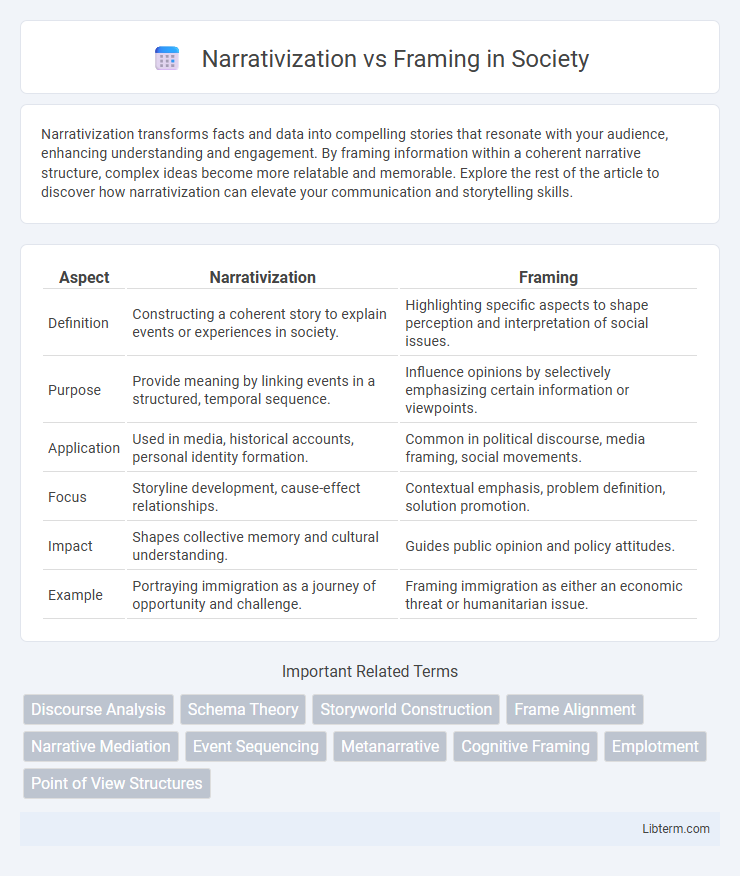Narrativization transforms facts and data into compelling stories that resonate with your audience, enhancing understanding and engagement. By framing information within a coherent narrative structure, complex ideas become more relatable and memorable. Explore the rest of the article to discover how narrativization can elevate your communication and storytelling skills.
Table of Comparison
| Aspect | Narrativization | Framing |
|---|---|---|
| Definition | Constructing a coherent story to explain events or experiences in society. | Highlighting specific aspects to shape perception and interpretation of social issues. |
| Purpose | Provide meaning by linking events in a structured, temporal sequence. | Influence opinions by selectively emphasizing certain information or viewpoints. |
| Application | Used in media, historical accounts, personal identity formation. | Common in political discourse, media framing, social movements. |
| Focus | Storyline development, cause-effect relationships. | Contextual emphasis, problem definition, solution promotion. |
| Impact | Shapes collective memory and cultural understanding. | Guides public opinion and policy attitudes. |
| Example | Portraying immigration as a journey of opportunity and challenge. | Framing immigration as either an economic threat or humanitarian issue. |
Understanding Narrativization: Definition and Key Concepts
Narrativization refers to the process of constructing and organizing information into a coherent story, emphasizing events, characters, and causal relationships to create meaning. Key concepts include narrative coherence, temporal sequencing, and the role of perspective in shaping how events are connected and interpreted. Unlike framing, which highlights specific aspects or angles to influence perception, narrativization builds a comprehensive and structured account that guides audience understanding over time.
What Is Framing? Core Elements and Principles
Framing refers to the process of shaping how information is presented and perceived by emphasizing certain aspects over others, influencing interpretation and decision-making. Core elements of framing include the selection of specific details, the organization of information, and the creation of meaning through context and language. Principles of framing involve highlighting problem definitions, attributing causes, making moral evaluations, and suggesting remedies to guide audience responses.
The Psychological Impact of Narrativization
Narrativization shapes the psychological experience by transforming disjointed events into coherent stories, enhancing meaning-making and emotional processing. This cognitive structuring reduces anxiety and fosters a sense of control by organizing experiences within a narrative framework. Unlike framing, which highlights certain aspects to influence perception, narrativization deeply integrates events into personal identity and memory, thus impacting mental well-being more profoundly.
Framing: Shaping Perceptions and Influencing Audiences
Framing shapes perceptions by selecting specific aspects of a topic to highlight, influencing how audiences interpret information and form opinions. It uses cognitive structures to guide attention, promote certain values, and elicit emotional responses, making it a powerful tool in media, politics, and advertising. Effective framing can reinforce stereotypes or challenge existing narratives, significantly impacting public discourse and decision-making processes.
Differences Between Narrativization and Framing
Narrativization constructs a coherent storyline by organizing events and experiences into a structured narrative, emphasizing temporal sequencing and causality. Framing highlights specific aspects of information to influence interpretation and perception, often through selective emphasis and context setting without necessarily creating a full narrative. The key difference lies in narrativization's focus on storytelling and chronological order, while framing centers on shaping meaning and guiding audience perception through particular perspectives.
The Role of Narrativization in Media Content
Narrativization structures media content by organizing events and information into coherent storylines that enhance audience engagement and comprehension. It shapes perception by creating relatable characters, plot arcs, and emotional connections, thereby influencing how messages are interpreted and remembered. This process contrasts with framing, which selectively highlights certain aspects or perspectives without necessarily constructing a full narrative.
How Framing Affects News Reporting and Analysis
Framing in news reporting shapes the audience's perception by emphasizing specific aspects of a story, influencing interpretation and emotional response. It guides the selection of facts, narratives, and language, often leading to biased or partial viewpoints that affect public opinion and policy debates. Unlike narrativization, which organizes events into a coherent story, framing strategically highlights certain themes to steer analysis and understanding.
Case Studies: Narrativization vs Framing in Current Events
Case studies in current events reveal that narrativization involves constructing a coherent story that connects disparate facts into a compelling narrative, while framing emphasizes highlighting specific aspects of an issue to shape audience perception. For instance, media coverage of climate change frequently employs narrativization by linking scientific data, policy debates, and human impact into a unified story, whereas framing might focus on economic consequences or environmental urgency to influence public opinion. Analyzing these strategies demonstrates how narrativization creates broader context and emotional resonance, whereas framing targets specific interpretive angles to guide understanding and response.
Ethical Considerations in Using Narrativization and Framing
Narrativization and framing both influence audience perception by selectively highlighting aspects of a story or issue, raising ethical concerns about manipulation and bias. Ethical use requires transparency in presenting multiple perspectives, avoiding distortion or oversimplification that can mislead or marginalize groups. Maintaining accuracy and respect for subjects ensures narrativization and framing uphold integrity in communication and foster informed, balanced understanding.
Strategies for Critical Consumption of Narratives and Frames
Narrativization involves constructing stories with coherent sequences of events and characters, while framing focuses on highlighting specific aspects of information to shape interpretation. Strategies for critical consumption include identifying underlying values, biases, and assumptions in both narrative structures and frames to assess their influence on perception. Analyzing source credibility, cross-referencing multiple perspectives, and questioning the intended emotional or cognitive impact enhance the ability to critically engage with narratives and frames.
Narrativization Infographic

 libterm.com
libterm.com